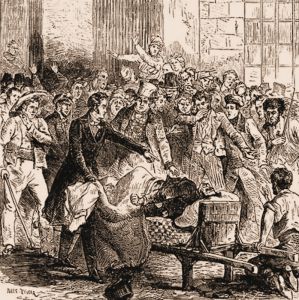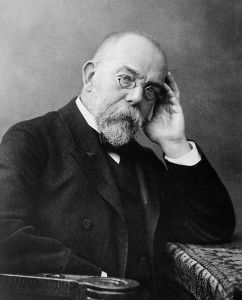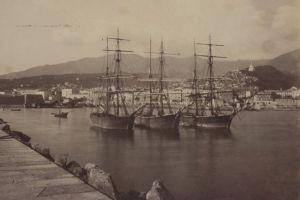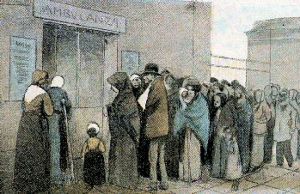1 - Cholera and smallpox In the mid-XIXth century San Remo had twice been hit by cholera, first in 1837 and then in 1854, once by typhus in 1846 and once by a smallpox epidemic in 1829, years in which many deaths were recorded.
In the mid-XIXth century San Remo had twice been hit by cholera, first in 1837 and then in 1854, once by typhus in 1846 and once by a smallpox epidemic in 1829, years in which many deaths were recorded.
However, Sanremo had miraculously escaped the Asiatic cholera epidemic which had hit Marseille, Nice and Genoa hard in 1865-67.
In the years when tourism took off on the Riviera (see History of Tourism) cholera still appeared to be the most problematic of the recurring diseases, in fact it triggered frightening spirals of death and at the same time discredited the affected cities from a hygienic point of view, due to the causes believed to produce it.
There were two theories about the causes.
The first one believed that it was the "miasma" derived from bad cleanliness, and advocated municipal intervention to maintain cleanliness in houses and courtyards, ordering the removal of garbage thrown on lawns and streets, making the urban cleaning service more effective, washing streets, drains and sewers, distributing enough water, rationalising the evacuation system of faecal matter.
The second was more modern and more scientifically correct and already spoke of small living organisms attacking humans, making them sick and carrying the disease. The infected had the ability both to contaminate healthy substances and to infect other people directly, so they believed that in order to prevent epidemics it was necessary to work on the sanitary side by isolating the people affected, disinfecting the homes of the infected, destroying foodstuffs from places affected by cholera, and banning the movement of people and things during alarm periods.
 When, in the '80s, Koch isolated the carrier reservoir, demonstrating the scientific validity of the contagion theory, the conflicting positions of the two factions were reconciled and the existence of two different forms of the same disease was recognised: the common and the contagious.
When, in the '80s, Koch isolated the carrier reservoir, demonstrating the scientific validity of the contagion theory, the conflicting positions of the two factions were reconciled and the existence of two different forms of the same disease was recognised: the common and the contagious.
Between 1882 and 1915, despite the fact that both Koch and Pasteur, a proponent of preventive vaccination, had laid the foundations of the bacteriological theory of infectious diseases, public opinion, even though it now considered contagion to be a possible scientific truth, essentially continued to believe that consumption and cholera were caused primarily by the poor hygienic conditions of the cities where they mostly broke out.

From the report of the "Vice Conservator of Vaccine" of 1869 it is explained that « Jenner, with his prodigious discovery, has taught us the means of ticking off the scythe at death, which with smallpox reaped endless victims; and if this means, eminently useful and necessary for public safety, were put into practice in the times indicated and prescribed by the law on vaccinations, we would no longer see the Province from time to time polluted by the Arab and deadly disease.
If, after the publication of this law, it has not been able to assume the proportions and characteristics of a widespread and serious epidemic, it has always, when introduced, claimed a few victims.
The vaccine that I have introduced is the offspring of the one discovered in the Province at the end of July last year: I have not yet observed any significant modification in its course, in the intensity of its symptoms and in its duration; and if it has sometimes presented some variation in its phenomenal aspect, I have always recognised that this must be attributed exclusively to the constitution and indisposition of the vaccinated person: it is also recognised that this vaccine enjoys greater virtues of transmission than the one that has already been passed on for many generations; whether it also enjoys greater virtues of preservation I do not know, time will show ».
A resurgence of smallpox disease was reported in 1872:
« The Provincial Board of Health, informed of the appearance of smallpox in the province and in some localities with quite considerable proportions, although aware that fortunately it is now decreasing, has nevertheless decided that given the approach of the summer season and certain local conditions the following measures to protect public health were necessary:
- not to admit to public or public schools those pupils who present fresh traces of smallpox recently suffered or who have smallpox individuals at home;
- if any person living in any of the above mentioned establishments was affected by smallpox or could have contact with smallpox, he should be immediately isolated and transported elsewhere, and when this was not possible the school should be temporarily closed giving notice at the same time to the Prefecture ».
In 1873 Dr. Raffaele Baratta of Pornassio discovered the original vaccine in the cows on our Alps of Lote and Tanarello: but since its efficacy did not last longer than 24 hours, it was recommended to report any infected cattle in our countryside to obtain the vaccine in less time. A further increase in the number of smallpox cases was reported in 1881 so it was recommended to avoid the use of public cars and railways to transport the affected people to the hospital in order to limit the spread of the disease.
A further increase in the number of smallpox cases was reported in 1881 so it was recommended to avoid the use of public cars and railways to transport the affected people to the hospital in order to limit the spread of the disease.
With a "Public Health Ordinance" of 1890, while noting that smallpox was in sharp decline, it was decided that all persons living in a building where a case of smallpox had occurred were obliged to undergo vaccination, regardless of whether they had already been vaccinated.
Things are going better in the whole Kingdom, but since in 1894 smallpox cases occurred in some places in France close to our border, the Mayors of the province are invited to « exercise a surveillance activity and adopt those preventive measures whose effectiveness to prevent the spread of this disease has been consecrated by a long practice ».
In the province the 61 cases of smallpox which occurred in 1894, fell to 25 the following year with 2 cases in San Remo (from Monaco).
Cholera, which claimed a large number of victims, caused the greatest concern. In 1870, a ministerial order was issued concerning the measures to be taken against ships coming from the Sea of Azov because of the development of cholera in Tagaurog. In the case of ships that had not served a regular in absentia in Constantinople or another intermediate port prior to arrival, the observation of the Sanitarians could only take place in ports or ports of call where complete isolation of the ships was possible.
In 1870, a ministerial order was issued concerning the measures to be taken against ships coming from the Sea of Azov because of the development of cholera in Tagaurog. In the case of ships that had not served a regular in absentia in Constantinople or another intermediate port prior to arrival, the observation of the Sanitarians could only take place in ports or ports of call where complete isolation of the ships was possible.
However, the official appearance of cholera in Italy was reported in 1873 and the Prefect promptly alerted the mayors:
« As Your Excellency may have learned from the newspapers, and as confirmed by a communication published a few days ago in the Official Gazette of the Kingdom, it seems to have been ascertained that cases of Asiatic cholera have appeared in some municipalities in the provinces of Treviso and Venice.
Although it is to be hoped that the fatal disease may remain confined to those municipalities, and that the sanitary conditions of this Province are excellent, it is not therefore the case that all the Authorities, especially the Municipal Authorities and the advisory bodies responsible by law for the protection of public health, have been able to prevent the disease from spreading.
Therefore, all the Authorities, especially the Municipal ones and the advisory bodies assigned by law to the protection of public health, must redouble their vigilance so that in every locality and especially in the most populated centres, all the hygienic prescriptions recommended by science and experience are scrupulously observed and carried out, in order to prevent the development of epidemic and contagious diseases.
These concern in particular the cleanliness of inhabited sites, the temperate ventilation of dwellings, and in particular of public establishments, the disposal of stagnant water, as well as the wholesomeness of foodstuffs placed on public sale and similar other precautions.
In the case of a well-founded fear that the aforementioned disease could also invade this Province, it will be the responsibility of the Municipal Representation to prepare everything necessary both for the care of the poor who are affected by the aforementioned disease, and to prevent its greater spread and diminish its disastrous and terrible effects. ».
A special poster, dated 26th July 1873, was also posted:
On 6th January 1874 the "cessation of cholera in the whole territory of the Kingdom" was ascertained.
After a decade the Prefect wrote to the Mayors in a letter dated 8th July 1883:
« Your Lordships will not be unaware that Asian cholera has appeared in nearby Egypt and that the terrible disease is spreading and worsening in that country, claiming numerous victims.
The sanitary measures that have been taken by the King's government are such as to reassure people, and it is to be hoped that they will be sufficient to keep the epidemic invasion away from Italy.
Nevertheless, and wisely foreseeing even the distant possibility that the disease may spread to these countries, it is necessary to be prepared so that, in the event, the epidemic may be more easily controlled and circumscribed ».
The letter goes on to make the well-known recommendations on prophylactic measures to be taken.
Further warnings followed in the same year:
« Following up on the previous circular, I must point out that the epidemic, in order to enter the borders of the State, can take both the sea route and the land route: in fact, sometimes a cloth, a rag, or any object containing the germs of the lethal disease is enough to make it break out in the country where the object is imported.
Arrangements have been made with the Intendant of Finance for the customs guards to concur in the sanitary vigilance, and I am convinced that the concurrence of that Corps will be a valid aid in safeguarding us from cholera.
However, since the precautions taken can never be too many, it is necessary that in this work the agents of the finance be helped effectively and in agreement by the people themselves. Now that the import of certain goods for sanitary purposes has been suspended, now that incoming ships have to undergo quarantine of greater or lesser duration depending on their origin, it is foreseeable that the clandestine introduction of goods will be attempted on a larger scale, and perhaps to the serious detriment of public health ».
The Municipal Council, in its meeting of 9 August 1883, resolved on urgent and important interventions for the construction of sewers, as requested by the Health Authority, « also in view of the dangers threatening public health in the Mediterranean countries, given the appearance and raging cholera in Egypt ».
In October 1883, a "Maritime Health Order, having « ascertained from official information that the sanitary conditions of the islands of Malta and Cyprus, of the city of Smyrna and of the whole of Syria remain satisfactory, decrees that the quarantine now in force for ships of the said origin, which have arrived with unharmed crossings, whatever their duration, is now reduced to 24 hours; and that, having also noted the considerable improvement in the sanitary conditions of Egypt and of all ports beyond the Suez Canal, the quarantine of ships coming from there will from today be established at 10 days without distinction ».
The order was then revoked on 24 March 1884.
But in the same year, the Prefect informed the Mayors: « Your Honours will probably be aware that in neighbouring France, and more precisely in the city of Toulon, a number of cases of a disease that has all the characteristics of Asiatic cholera and was defined as such, have appeared in recent days.
« Your Honours will probably be aware that in neighbouring France, and more precisely in the city of Toulon, a number of cases of a disease that has all the characteristics of Asiatic cholera and was defined as such, have appeared in recent days.
In view of this, the King's Government has taken strict sanitary measures to reassure people and it is to be hoped that these will be sufficient to keep the disease away from Italy.
However, since it is foreseeable, as prudence would have it, that the epidemic may spread to these countries, it is necessary to be prepared in order to be able to control and contain it more easily.
I therefore order that the mayors should already be thinking about the premises in which the lazaret for the cholera sufferers could be established, so that they will not be caught unawares in the event of a cholera invasion ».




